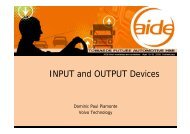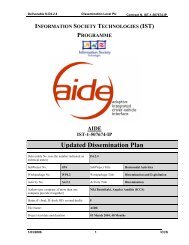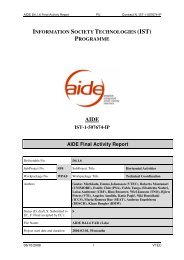download deliverable - AIDE
download deliverable - AIDE
download deliverable - AIDE
You also want an ePaper? Increase the reach of your titles
YUMPU automatically turns print PDFs into web optimized ePapers that Google loves.
Deliverable D4.2.1 Dissemination Level PU Contract N. IST-1-507674-IP<br />
I/O Devices<br />
ICA<br />
Application<br />
Figure 3: Communication flow between ICA and applications<br />
3.10.4. DVE component<br />
The description above also makes clear that the ICA module needs information about<br />
the driver and the environment. Therefore, the DVE component sends this information to the<br />
ICA module. The DVE component includes the DVEM (driver vehicle environment<br />
monitoring) which uses several sensor information to detect defined driver states, driving and<br />
environment situations and it includes the PM (profile manager) which manages the driver<br />
preferences. Those two modules are combined in the DVE component because the<br />
distribution strategy of that information might be the same and all those information are used<br />
by the ICA to adapt the HMI output strategy.<br />
It was recommended to separate the DVEM module in three modules (environment,<br />
driver and vehicle), since it might be easier to integrate results from other IP's like<br />
environment information from the PREVENT project.<br />
The DVE information also is fed to the applications because some condition<br />
dependent adaptations can only be performed by the application itself, e.g. if a ACC<br />
application should warn earlier in case of high driver demand that is only known by the<br />
application itself and not by the ICA<br />
Furthermore the content of the DVE information was discussed. It was stressed out<br />
that this information has to be generalised, which derives from sensor fusion raw material.<br />
Thus, for example the driver demand will be provided in different levels which have to be<br />
derived from several raw sensor information. The necessary conditions clearly depend on the<br />
individual solutions which should be provided. Within <strong>AIDE</strong>, a first subset of conditions is<br />
chosen which might be extended in the future work.<br />
3.10.5. I/O device access:<br />
In the first step, the <strong>AIDE</strong> architecture does not allow a direct access of the I/O<br />
devices by the applications which is state of the art today.<br />
Figure 4 illustrates the I/O device access principle. The application addresses virtual<br />
device to present information to the driver. Thus, there is no difference from the application<br />
point of view compared to today. The only difference is the availability for the driver, i.e. the<br />
addressed virtual device or proxy do not effect the real output device. The ICA component<br />
acts as a switching device and connects the proxy and the real device when it allows the<br />
desired output.<br />
This approach prevents the system from timing problems, i.e. if for example an output<br />
has to be interrupted and a new, more important one has to be presented the ICA can switch<br />
25/07/2005 36 ICCS







